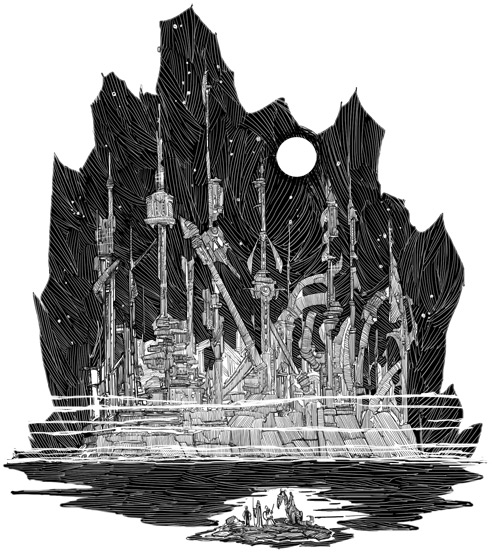Review: A tour of Carcosa
by Ramanan Sivaranjan on September 23, 2012
Tagged: carcosa lotfp osr hexcrawl

1507: On a lifeless island of black stone stands the alien city of Carcosa.
A silhouette of this city is featured on the cover of Carcosa. The city is only mentioned once in the book, in this description. It’s certainly an evocative sentence.
Carcosa concludes with a tour of its world via a hex map and descriptions of those hexes. As has been a running theme in my reviews of the book1, the details of each hex are quite terse. Geoffrey McKinney continues to say the bare minimum needed to convey anything at all about the world he has created. There is definitely something old-school in this sort of presentation.
Each hex description includes two possible things the PCs could come across. The first description is written by McKinney, and was the only description presented in the original booklet version of Carcosa. The second set of descriptions were created by fellow gamer and fan of the setting Chris Robert; he had previously published these descriptions as a free PDF, Strange Sights of the Doomed World Carcosa.
McKinney’s descriptions are very matter of fact. There is a village here; there is a disgusting monster there. Occasionally he will hint at something sinister or exciting, but it’s just a hint. Robert’s descriptions are somewhat similar in tone, but are a bit more varied in their execution. I can imagine coming up with my own set of encounters, using Robert’s take on things as a good example of how to proceed.
The hex descriptions of Carcosa can be split into three types of encounters: villages and citadels, spawns of Shub-Niggurath, and the “weird”. That last category is broad, clearly.
402: Here looms the great and extinct black volcanic Mount Voormith’adreth, honeycombed with weird and outré caverns, and beneath which bubbles and heaves Shub-Niggurath.
This is a pretty important place in Carcosa. It’s home of Shub-Niggurath, the creator of almost all the important species on the planet. Spawns of Shub-Niggurath are one of the most common creatures encountered on the planet. This little passage is all that McKinney dedicates to their creator’s home.
1610: Village of 370 Red Men ruled by “the Lover of Peace,” a lawful 5th-level Sorcerer.
This is your typical village description: here are some men and this is their leader. You can often get a sense of what the village will be like based on the leader’s alignment and title.
1609: Citadel of 83 Bone Men led by a chaotic 6th-level Fighter.
Some times descriptions are even more terse. Who knows what this village is like? The village is 6-12 miles from the citadel. Maybe there is a relationship there? Carcosa encourages thinking like this.
1513: Ulfire Mold.
The tersest hex description possible? The alternate encounter for this hex, by Robert’s, is a bit more meaty.
1513: The undying and practically invisible brain of a chaotic Bone Man Sorcerer lies shallowly buried in the reeking fens of this hex. It is eager to find new flesh, though discriminating enough to consider only a fellow Bone Man as an acceptable vessel. Any Bone Man coming with 100′ of the brain must make a saving throw vs. magic. Failure indicates that he is compelled to unearth the brain, tear his own brain from his head, and replace it with the Sorcerer’s brain. If this occurs, the Sorcerer will take the first opportunity to escape to his secret lair in hex 0715, there to resume his experiments into the forbidden.
There are lots of interesting little encounters to be had throughout Carcosa. Even if you weren’t interested in running a game in the settings there is definitely stuff one could steal here.
The book concludes with a short adventure and random tables to aid a DM in running a hex crawl on the planet. The adventure is presented as a keyed dungeon and a mini hex-crawl. Besides wandering monster tables, we also get a table for creating alien technology, one for making spawns of Shub-Niggurath, and one for making random robots.
If it’s not clear by now, I really liked Carcosa. The book is physically fantastic. It’s definitely worth buying for Rich Longmore’s art alone. His illustrations of the setting are incredible. The pictures i’ve used in my reviews are a small sampling of the stuff in the book. The fact the material itself is also quite good was a nice bonus. I didn’t expect to enjoy this book as much as I did. I had no real interest in hex-crawl adventures, Lovecraft, weird sci-fi in my fantasy, or half the things that Carcosa is all about. McKinney has done a great job in sharing the things that he likes about D&D. You should buy this book already.
-
Previous reviews: Carcosa, Carcosa’s vile black magic, and The monsters of Carcosa ↩
Go back in time, add me to your circles, and we can discuss post on on google+.
